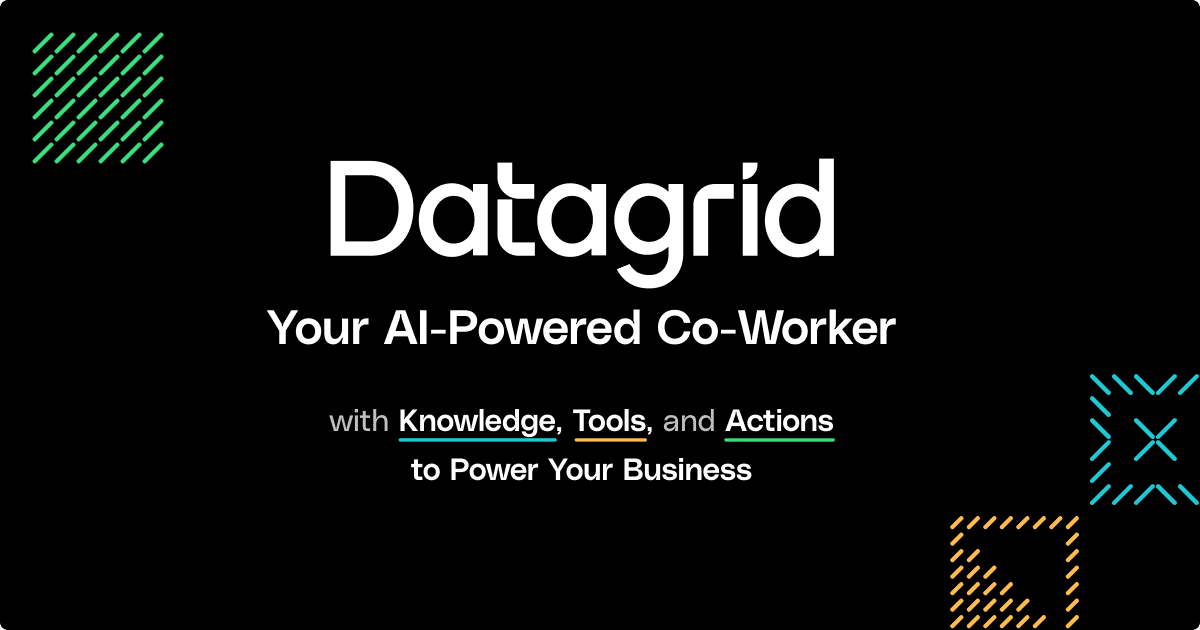All Posts
Productivity tools and techniques
The Complete Guide to Insurance Data Integration Automation

This article was last updated on January 24, 2025
In today's insurance landscape, the single biggest challenge is grappling with massive amounts of fragmented data—spanning claims, customer interactions, and compliance requirements—to extract actionable insights. Learning how to automate insurance data integration is key to overcoming these challenges.
Thanks to breakthroughs in Agentic AI technology, insurance companies can now automate and streamline their data integration processes with unprecedented efficiency. Datagrid’s data connectors offer a powerful way to solve the data fragmentation problem, helping insurers unify critical information streams and accelerate their analytical capabilities.
Introduction to Insurance Data Integration Automation
The challenges of manual data processing run deep within insurance operations. Companies struggle with multiple communication channels—from traditional call centers and paper forms to modern self-serve portals and chatbots.
Each channel generates its own stream of data, creating a complex web of information that's difficult to reconcile and integrate. As noted by industry experts at SPIXII, these disparate data sources often lead to inconsistencies across organizations, creating bottlenecks in smooth integration and hindering effective communication between departments.
The business impact of these inefficiencies extends far beyond operational hiccups. Claims processing slows down, risk assessments become less accurate, and customer service suffers. Insurance professionals frequently report an absence of business intelligence in standard practices, with each business unit maintaining its own methods for data retrieval. Such a fragmented approach creates data silos that prevent insurance companies from realizing the full potential of their data assets.
The insurance industry's digital transformation has reached a critical juncture where automation isn't just an option—it's a necessity. Modern automation solutions can transform how insurers handle data integration by:
- Streamlining data collection across multiple channels
- Standardizing data formats and ensuring consistency
- Reducing manual entry errors through automated validation
- Accelerating processing times for claims and applications
- Enabling real-time data analysis for better decision-making
As reported by Zenphi, insurance companies implementing automation are seeing dramatic improvements in operational efficiency, data accuracy, and customer satisfaction. That shift towards automated data integration represents more than just a technological upgrade—it's a fundamental transformation in how insurance companies operate in our data-driven world.
Understanding Insurance Data Integration Challenges
Insurance companies face increasingly complex challenges in managing and integrating their data, significantly impacting both operational efficiency and customer service quality. Let's explore the four major challenges that make data integration particularly demanding in the insurance sector.
Multiple Data Sources and Formats
Insurance companies operate across numerous communication channels, from traditional call centers and paper forms to modern self-serve portals, mobile apps, and chatbots. While this multi-channel approach aims to improve customer service, it creates a complex web of difficult-to-reconcile data sources.
Each department typically maintains its own data repositories and analytics functions, with limited information sharing between units. This siloed approach leads to inconsistent terminology and bottlenecks in data integration, preventing insurers from realizing the full potential of their data assets.
Data Quality and Consistency Issues
Data accuracy is a critical concern, with studies showing that up to 30% of data in insurance databases can be inaccurate. Common issues include duplicate entries, outdated information, and inconsistencies across platforms. These problems often stem from manual data entry errors and inconsistent data collection practices across different departments. Poor data quality not only affects operational efficiency but also erodes customer trust when they receive incorrect information about their policies or claims.
Regulatory Compliance Challenges
The insurance industry operates under strict regulatory oversight, with frameworks like GDPR in Europe and various state-level privacy laws in the U.S. imposing rigorous requirements on data handling. Insurance companies must ensure that all customer data collection, storage, and processing activities comply with these regulations, often necessitating comprehensive Privacy Policies. This compliance burden adds complexity to data integration efforts, as companies must maintain robust data governance frameworks while managing the risk of substantial fines and reputational damage for non-compliance. Companies must also adhere to specific Terms of Use and legal agreements governing data exchange and usage.
Resource-Intensive Manual Processes
Perhaps the most significant operational challenge is the continued reliance on manual data processing. Industry reports indicate that organizations can spend up to 40% of their operational time on manual data handling. Tasks such as data entry, reconciliation, and reporting are not only time-consuming but also prone to human error. This heavy reliance on manual processes results in slower response times to customer inquiries and claims processing, directly impacting customer satisfaction and operational efficiency.
Such challenges are interconnected, with issues in one area often exacerbating problems in others. For example, multiple data sources increase the likelihood of data quality issues, while manual processes make it more difficult to maintain regulatory compliance. As insurance companies continue to collect and process growing volumes of data, addressing these challenges becomes increasingly critical for maintaining competitive advantage and delivering superior customer service.
Essential Components of Automated Insurance Data Integration
Modern insurance data integration requires several sophisticated technologies working in harmony to deliver efficient, accurate, and scalable solutions. Let's explore the core components that make successful automation possible.
AI and Machine Learning Technologies
At the heart of modern insurance data integration lies artificial intelligence and machine learning capabilities. These technologies, including advanced AI agent architectures, form the foundation for intelligent data processing and decision-making. In 2021, insurance companies invested significantly in big data analytics, leading to remarkable returns including a 30% increase in efficiency and 40-70% cost savings.
AI and ML technologies enable:
- Predictive analytics for risk assessment and customer segmentation
- Pattern recognition for fraud detection
- Automated data classification and routing
- Continuous learning and improvement of processing accuracy
- Methods like Retrieval Augmented Generation further enhance these capabilities
OCR and Intelligent Document Processing
Optical Character Recognition (OCR) and Intelligent Document Processing (IDP) work together to transform unstructured documents into structured, actionable data. Such technologies are crucial for handling the diverse document types common in insurance:
- Policy applications and forms
- Medical records and claims documentation
- Accident reports and witness statements
- Legal documents and correspondence
IDP goes beyond basic OCR by combining it with AI and machine learning to understand context and meaning, enabling advanced tasks such as extracting data from PDFs. This allows for automated extraction of relevant information while maintaining accuracy and reducing manual review requirements.
Data Validation and Enrichment Tools
Data quality is paramount in insurance operations, where accuracy directly impacts compliance and risk assessment. Data validation and enrichment tools serve as quality control mechanisms by:
- Automatically checking for inconsistencies and errors
- Verifying data integrity across systems
- Enriching datasets with external information
- Maintaining compliance with industry standards
These tools help ensure that all data entering the system meets quality standards and regulatory requirements, reducing the risk of costly errors and compliance issues.
Integration Platforms and APIs
The final crucial component is the integration infrastructure that connects all these systems and enables seamless data flow. Modern integration platforms and APIs facilitate:
- Real-time data exchange between systems
- Secure connections with third-party services
- Standardized data transformation and mapping
- Scalable processing capabilities
Integration platforms also enable both real-time and batch processing, allowing insurance companies to handle immediate and large-scale data operations effectively. Such flexibility is essential for managing varying workloads and meeting different business requirements.
By implementing these essential components together, insurance companies can create a robust automated data integration system that improves efficiency, reduces errors, and enables better decision-making across the organization. The key is ensuring these components work together seamlessly while maintaining data security and regulatory compliance throughout the process.
Step-by-Step Guide to Implementing Automation
Assessment and Planning Phase
Start by conducting a thorough evaluation of your current processes and data landscape. Map out workflows that are prime candidates for automation, particularly focusing on data-intensive processes like claims processing, underwriting, and policy management.
Begin with these key steps:
- Document existing workflows and identify bottlenecks
- Calculate current processing times and error rates
- Map data sources and their interconnections
- Identify manual processes that could be automated
Set clear, measurable objectives for your automation initiative. For example, if you're automating claims processing, target specific metrics like reducing processing time by 30%.
Technology Selection and Integration
When selecting automation technologies, consider these critical factors:
- Compatibility with existing systems
- Scalability for future needs
- Integration capabilities with multiple data sources
- Support for insurance-specific requirements
Pay special attention to legacy system integration. Many insurance companies operate with decades-old systems that contain valuable historical data. Your automation solution must bridge the gap between these legacy systems and modern platforms while maintaining data integrity.
Data Mapping and Transformation Setup
Create a comprehensive data mapping strategy that addresses:
- Source system identification
- Data quality assessment
- Standardization requirements
- Transformation rules
Establish data quality standards and validation processes. This is crucial as insurance data often comes from multiple sources with varying formats and quality levels. Implement data cleansing procedures to ensure consistency across all systems.
Key considerations for data transformation:
- Define standard formats for common data elements
- Create validation rules for insurance-specific data
- Establish error handling procedures
- Document transformation logic
Testing and Quality Assurance
Implement a robust testing strategy that includes:
- Unit Testing
- Test individual automation components
- Validate data transformation rules
- Verify calculation accuracy
- Integration Testing
- Test end-to-end processes
- Verify system interactions
- Validate data flow between systems
- User Acceptance Testing
- Involve business users early
- Test real-world scenarios
- Validate business outcomes
Set up monitoring mechanisms to track key performance indicators (KPIs) such as:
- Processing time improvements
- Error rate reduction
- Data quality metrics
- System response times
Deployment and Monitoring
Roll out your automation solution using a phased approach:
- Pilot Phase
- Select a specific process or department
- Monitor closely for issues
- Gather user feedback
- Make necessary adjustments
- Full Implementation
- Expand to other processes gradually
- Provide adequate training
- Monitor system performance
- Document lessons learned
Establish ongoing monitoring procedures to ensure continued success:
- Regular performance reviews
- System health checks
- User feedback sessions
- Continuous improvement initiatives
Remember to maintain detailed documentation throughout the implementation process. That documentation should include:
- Technical specifications
- Process flows
- Integration points
- Troubleshooting guides
- Training materials
By following this structured approach, you can minimize risks and ensure a successful automation implementation. The key is to remain focused on your specific insurance industry requirements while maintaining flexibility to adapt to changing needs and emerging technologies.
Benefits and ROI of Automated Insurance Data Integration
Operational Efficiency Improvements
Insurance companies implementing automated data integration systems are seeing dramatic improvements in their operational efficiency. Time savings of up to 30% in claims processing and policy management have become the norm. In practical terms, this means processes that previously took 10 days can now be completed in just 3 days, allowing staff to focus on more complex tasks that require human judgment and creativity. These efficiency gains not only speed up operations but also enhance team performance by allowing employees to focus on strategic tasks.
Cost Reduction and Resource Optimization
The financial impact of automation is substantial and measurable. Insurance companies report operational cost reductions ranging from 20-40% after implementing automated data integration systems. For example, a major insurance firm achieved approximately $2 million in annual savings by automating their data integration processes, enabling them to reallocate resources to strategic initiatives like customer service enhancement and innovation projects.
Enhanced Data Quality and Compliance
Automated systems significantly improve data accuracy and regulatory compliance. Insurance companies using automated data integration have reported a 25% decrease in data errors, directly correlating with improved compliance rates. In one notable case, an insurer that automated its reporting processes achieved a 50% reduction in compliance-related fines over a two-year period, demonstrating the substantial financial benefits of improved data quality.
Improved Customer Experience
The impact on customer satisfaction is equally impressive. Insurance companies utilizing automated systems have seen customer satisfaction scores improve by 15-20%. Such improvement is largely attributed to faster response times and more accurate information delivery. One insurance provider reduced their customer inquiry response times from 48 hours to under 1 hour, significantly enhancing customer engagement and loyalty. Such improvements in customer experience translate directly into higher retention rates and increased customer lifetime value.
How Agentic AI Simplifies Insurance Data Integration
Insurance companies are witnessing a transformative shift toward more intelligent, autonomous data processing, with 82% of large companies planning to implement AI Agents by 2027; Agentic AI revolutionizes insurance data integration through several key capabilities:
Automated Data Enrichment
The technology automatically enhances existing datasets with relevant information from multiple sources, eliminating manual data entry and research tasks. This automation ensures insurance companies maintain comprehensive and up-to-date information for underwriting and claims processing, while allowing teams to focus on strategic activities rather than routine data gathering.
Intelligent Task Execution
Agentic AI excels at autonomously handling complex workflows. The system can analyze vast amounts of data to identify patterns and anomalies, enabling faster decision-making in risk assessment and claims management.
Seamless Integration Capabilities
The technology facilitates unified data integration across various platforms and systems. By connecting with over 100 apps and tools, Agentic AI creates an integrated ecosystem where information flows seamlessly between different platforms, from CRM systems to claims databases and underwriting tools. This integration eliminates manual data transfer and reduces error risks.
Advanced Analytics and Reporting
Agentic AI automates the generation of reports and analytics, providing real-time insights without manual compilation. The system can analyze data from multiple sources simultaneously, offering valuable insights for decision-making and operational optimization. This capability ensures that insurance professionals have access to up-to-date information when needed.
Streamlined Communication
The technology enhances collaboration by automating communication processes across various channels. It can send personalized notifications, reminders, and updates through email, Slack, and other platforms, ensuring all team members stay informed without constant manual follow-ups. This streamlined communication is crucial for maintaining efficient workflows and quick decision-making processes.
By implementing these AI-powered solutions, insurance organizations can significantly reduce time spent on administrative tasks while improving accuracy and efficiency. The technology's ability to handle complex data operations autonomously allows employees to focus on strategic activities that drive business growth and innovation, fundamentally transforming how insurance companies manage and utilize their data.
Simplify Insurance Data Integration with Agentic AI
Ready to tackle the persistent challenge of fragmented insurance data? Datagrid puts these capabilities at your fingertips with:
- Seamless integration across 100+ platforms
- AI-driven data analysis and automation
- Real-time insights and analytics
- Automated task management
- Enhanced fraud detection capabilities
Take the first step toward eliminating data silos and revolutionizing your insurance data integration. Contact Datagrid today to request a demo and discover how our AI-powered solutions and data connectors can unify your information ecosystem, streamline operations, and boost your competitive edge.












